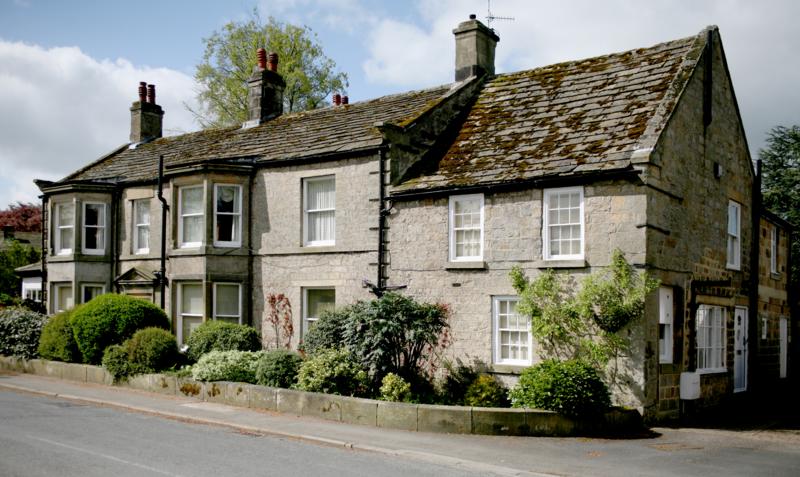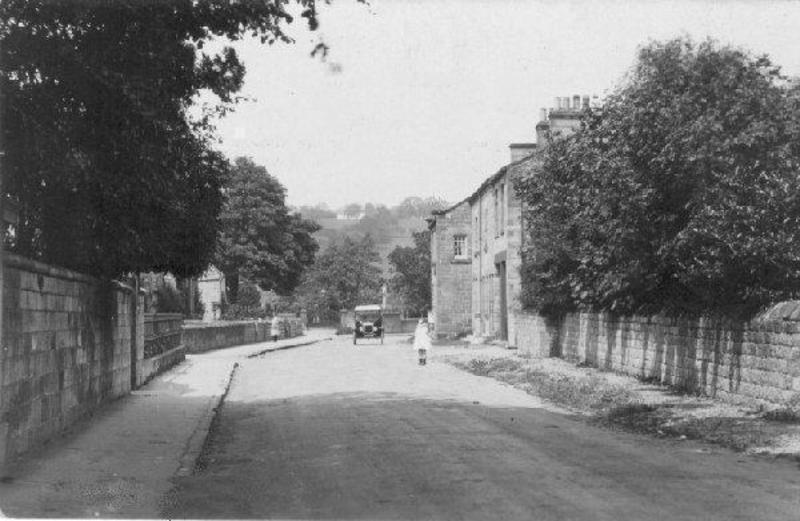Thimbleby House
 (click on photo for a larger image in a new window)
(click on photo for a larger image in a new window)
If the date-stone (1755) built into this house is correct then the property is one of the oldest in Church Lane and probably contemporary with The Lamb Inn on the opposite side of the road. However, the several architectural styles evident in the photograph above strongly suggest a series of changes to the accommodation over the centuries. To the left of the picture we see what appears to be a double - fronted building with matching bay windows. Its style is consistent with a construction date early in Victorian times. The pediment over the central ground-floor window suggests the existence of a central doorway there when first built but the position of a chimney-breast above is odd (if both bays were constructed at the same time would not the chimney have been constructed on the right-hand gable wall?). There is a difference of proportion in the further section of building to the right of the second bay albeit it has a continuous roof with the rest of the building on the left. The further section of the house on the extreme right has a different and more antiquated roof altogether! That right-hand section, moreover, appears much older than the rest of the building. It may be that section which is the earliest and that the house has been extended southwards several times over the years.
Jeffrey's Map of 1770 is the earliest map we can presently refer to but it is crudely drawn and unreliable - it shows the parish church standing on this site! The first Ordnance Survey Map of 1853 shows some portion of the present house standing on the site but, again, is of scale difficult to reconcile with the present layout. The strongest evidence for the antiquity of the house (or parts of it) comes from the title deeds (as to which please click on
previous owners).
 (click on photo for a larger image in a new window)
(click on photo for a larger image in a new window)
This photograph from the early 20th century gives a glimpse of the handsome iron railings which once surmounted the front boundary wall - another victim, no doubt, of the drive for scrap metal material during the second world war! Another old photograph recently to hand gives an even better view of the railings (and a glimpse of an interesting conversation?).
 (click on photo for a larger image in a new window)
(click on photo for a larger image in a new window)
The house has had a number of distinguished occupants including several medical practitioners. In "Harrogate and the Forest of Knaresborough" published 1871, William Grainge says that it was the residence
"of the late Mr. Bilton Josephus Wilson, who was an extensive landowner in this district, as well as the most munificent benefactor the parish of Hampsthwaite ever had. On the mother's side he was descended from the old and respectable family of Bilton, who have been landowners in the Forest of Knaresborough from a very early period . . . (his mother, Mary, married Joseph Wilson, later Vicar of Hampsthwaite, and Bilton was born in 1778. He married Sarah Simpson in 1836 and died, without issue, in 1866. Sarah died in 1869). . .
Mr. Wilson was educated for the medical profession, but never practised, except among his poor neighbours, to whom (before a doctor settled in the village) he freely gave his advice and medicine. During the whole of his life he was remarkably benevolent and kind to the poor. He died somewhat suddenly, though slightly indisposed; he took tea as usual on the day of his death, when a fainting fit came on, from which he never recovered. When the school in Hampsthwaite was built he was the largest subscriber; and on the 25th of January, 1865, he transferred £1,500, new three per cent annuities, to four trustees, to form a perpetual endowment for the said school. By his will he bequeathed £100 to the Leeds Infirmary, £100 to the Harrogate Bath Hospital, £100 to the Church Missionary Society, £100 to the Society of Oddfellows at Hampsthwaite, and directed his executors to distribute his annual gift of £40 to the poor of the village, on the New Year's Day next after his decease"
Annie Pawson (see Book One) refers to one of the last medical practitioners when she says . . .
"There was a resident doctor in the village, Dr. Ashby, who died in 1913. My brother, born in 1912, was the last baby that he brought into the world. He lived at Thimbleby House, where the Bowen's are now (i.e. in 1981-followed by the Faber's and then the Hudson's), for years and years. He had a family born to him there. The house had a very wide back door and, if anyone went for medicine at night, the housekeeper would answer the door, ask what was wanted and pass the packet through a plate-sized hole in the door, which had a shutter that swivelled round. There were no free prescriptions then and the doctor would do little operations himself. He was marvellous."
Click here for census returns.
Return to main map
 (click on photo for a larger image in a new window)
(click on photo for a larger image in a new window)
 (click on photo for a larger image in a new window)
(click on photo for a larger image in a new window)
 (click on photo for a larger image in a new window)
(click on photo for a larger image in a new window)
 (click on photo for a larger image in a new window)
(click on photo for a larger image in a new window)
 (click on photo for a larger image in a new window)
(click on photo for a larger image in a new window)
 (click on photo for a larger image in a new window)
(click on photo for a larger image in a new window)






